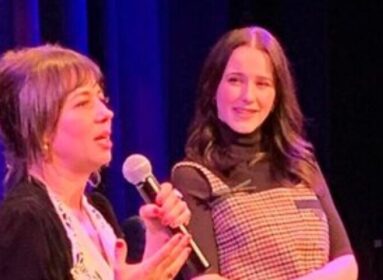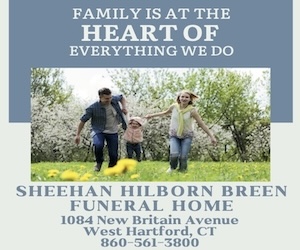 NEW YORK, N.Y. — When Jake Ehrenreich was growing up in the East Flatbush section of Brooklyn in the 1960s, he wanted nothing more than to be an American. But his Yiddish-speaking parents, who failed to understand the game of baseball or make sense of rock music, made it difficult for him to feel part of the mainstream culture. In his long-running, one-man musical show, A Jew Grows in Brooklyn, Ehrenreich explores how his family history, dominated by the shadow of the Holocaust, shaped the man he turned out to be.
NEW YORK, N.Y. — When Jake Ehrenreich was growing up in the East Flatbush section of Brooklyn in the 1960s, he wanted nothing more than to be an American. But his Yiddish-speaking parents, who failed to understand the game of baseball or make sense of rock music, made it difficult for him to feel part of the mainstream culture. In his long-running, one-man musical show, A Jew Grows in Brooklyn, Ehrenreich explores how his family history, dominated by the shadow of the Holocaust, shaped the man he turned out to be.
A prolific singer, musician, dancer, and writer, Ehrenreich, 55, has appeared on Broadway in Dancin’, Barnum,” and They’re Playing Our Song. He has also performed Yiddish music in two Off-Broadway productions, Songs of Paradise and The Golden Land.
His father’s Chasidic family had been one of the wealthiest in Poland, but during the war both he and his wife ended up in a work camp in Siberia, where one of their daughters was born. After spending time in a displaced persons camp, the family came to America, where Ehrenreich and his two sisters grew up feeling, as he put it, that the “world could end at any moment.” Yet he also shares many wonderful memories of his youth, from playing stoop ball to attending Shea Stadium to vacationing in the Catskills.
Solomon Schechter Day School of Greater Hartford will present Jake Ehrenriech in A Jew Grows in Brooklyn at its 2013 Spring Scholarship Event on Wednesday, May 22 at the University of Hartford’s Millard Theater. The evening will also honor Rabbi Jim and Nancy Rosen of West Hartford.
Recently, the Ledger spoke with Jake Ehrenreich about his show.
Q: You must really have arrived. After all, the Carnegie Deli in Manhattan has named a sandwich after the show. Who chose the ingredients?
A: Carnegie Deli owner Sandy Levine designed it, with corned beef, pastrami, turkey, lettuce, tomato, Russian dressing, and broccoli garnish. If it was me, I would have pastrami on rye with a lot of mustard, but a publicity person said that we needed a tree, so that’s where the broccoli came from. I’ve only eaten it once.
Q: Now to the more serious stuff. Some U.S. Jewish communities in the ‘60s had large populations of Holocaust survivors and children of survivors. Was your Brooklyn neighborhood like that for you?
A: There were very few children of survivors in my neighborhood and, in retrospect, those of us who were children of survivors never talked about it, and I didn’t even know that there were others like me. We’ve been making a documentary for PBS and we went back to my old neighborhood and talked with some of my old friends. As a kid, I felt that I didn’t fit in as “Yanke” and I felt apart. But everybody we talked to said the same thing: “I felt apart,” “I felt different.” It was so interesting that so many of us felt left out, for one reason or another. There were Jews in my neighborhood and non-Jews, and even with the Jews – they had names like “Michael” or “Gary,” but not “Yanke” – and there were more “American” Jews: their parents didn’t have accents and their homes were not dark in the way ours was. They had cousins and aunts and uncles and grandparents.
Q: Why did you decide to write your show?
A: It began as a tribute to my father. He was an extraordinary person and I and the community learned so much from him. That was in 2004, as his 80th birthday was approaching. I started thinking, How long will he be around? Rather than do a retrospective for him after he’s gone, why not do a tribute while he’s alive?
I put together a book of his published writings – he had written 300 articles on Judaism and the Holocaust – and we gave it out to all the guests, and I did a performance with a band and a video and stories. I worked with a Broadway drummer who thought it was great and we wanted to do more with the story. In the back of my mind, I remembered doing shows with multimedia and thinking, “One day I’ll do a show like that.” I did: I told my parents’ story in “The Golden Land,” and planned to tell my own story, which is the American story of being a child of immigrants and trying to integrate.
It took a year to write the first draft. First, I would take my daily six-mile walk on a road near my house and think about things I wanted to write about. I gathered as many family photos as I could and put together a history in my mind, but I also looked for things I could find the humor in, because this is a pretty sad story. We lost all our family, and in modern times, my mother and both sisters had early-onset Alzheimers. My mother died at age 63; one sister died at 55, and my other sister went into a nursing home.
I decided that I didn’t want to tell a Holocaust story that is really difficult to get through – even I find it hard to watch most Holocaust stories – but I wanted to tell a story that people could access. The best way to do that is to entertain, make people laugh, use a lot of music. I found that I could tell a serious story using that structure. In order to really get the story out, I had to package it in a way where people would tell their friends to see the show and come out knowing something they didn’t before and feeling good. There had to be a structure that was something of an emotional rollercoaster, some way to get me out of a sad section, to move on and show how we healed. So I tell the story and use the funny photos as asides.
Ultimately, the end of the story is my own life: we survived. I have a beautiful family and a son and we’re here in this country. I want to talk about the future and the joy of being grateful for the circumstances that we can be grateful for. Remembering is one thing, dwelling is another. I do remember the Holocaust and it’s a deep part of me, but I don’t live in the Holocaust; I live now and for those family members who were lost. What was also important is that I didn’t water it down to the point where I was no longer telling the serious story. While there is a lot of humor in the show, there are no jokes around the Holocaust.
We did a couple of development performances to get audience reactions, then debuted in 2006.
Q: How did you know that you’d created a good show?
A: I was gratified when the machers came to the show – Alan Dershowitz, Rabbi Marvin Heir of the Wiesenthal Center, Michael Berenbaum of the U.S. Holocaust Memorial Museum in D.C. – that was the test to see if I had dealt with this serious subject with enough respect, and they were universally accepting. That’s almost more important in a way than theatrical reviews.
My mother had passed; my father had Parkinson’s disease but it had only affected him physically; he had his wits about him until the end. He was in a wheelchair and came to our first development run in Westchester. He was so kind about it – he was not one for a lot of kudos – and he said, “I thought I found the cure for Parkinson’s because I didn’t shake once during the show.” We got a beautiful review from the New York Times and I showed him and he had no big reaction. A week later, I brought him a letter that someone had written me, a particularly nice one, and he freaked out and I said, “You barely reacted to the Times review. What’s so great about this letter?” He said, “A reviewer has to review your show but when someone takes the time out of their life to write you a letter, that’s what’s important.” I thought of that old expression, “The older I get, the smarter my parents get.”
Q: What have you gotten out of doing the show?
A: The show is very personal. This is a very specific true story and since it’s my story, I get to relive it and revisit the people in it. There are spots in the show where I open it up and people talk to me and say really funny things about their own lives. That always keeps me on my toes.
What I want to express in the show is that what I talk about is my set of challenges. But we all have challenges – that’s life – and the journey is to figure out how to live in the light, how to define your circumstances in as positive a way as possible. After each performance, when people come up to talk to me, I realize that everyone in the audience probably has things they’re thinking about while watching me: they think about their parents, their challenges, how they deal with those challenges. We’re all essentially living the same human journey.
I meet a lot of children of survivors who are not in such good psychological shape. What their parents lived through, what they lived through, is not so easy – but there are lots of things that are not so easy. I wish I could say to every person, “Just change your view about this, just look at it differently,” but everyone has to find that for themselves. And it’s not like you learn it once: you have to keep learning it over and over. You get sucked in to the day-to-day, into taking things for granted, and you forget the beauty around you. Life has to be more fulfilling than just what the individual will get out of it – and good luck trying to teach that to your children. But ultimately, they have to find it for themselves.
Jake Ehrenreich’s “A Jew Grows in Brooklyn” will be presented on Wednesday, May 22, 7 p.m. at Millard Theater on the campus of the University of Hartford. For more information on the show and Solomon Schechter Day School’s 2013 Spring Scholarship event call (860) 768-4228.
Comments? email cindym@jewishledger.com.








 Southern New England Jewish Ledger
Southern New England Jewish Ledger








